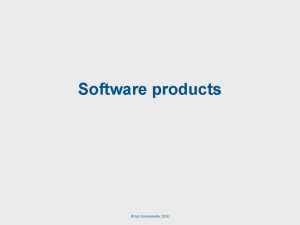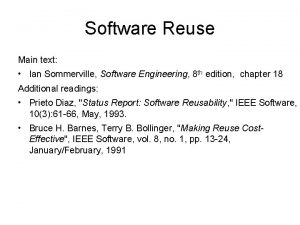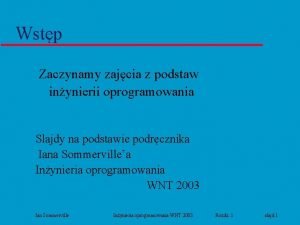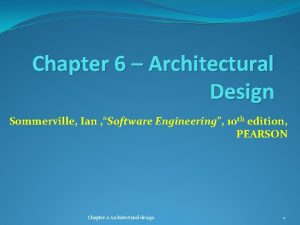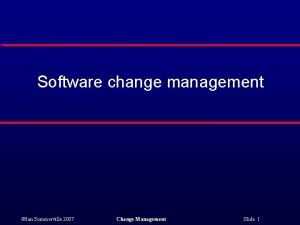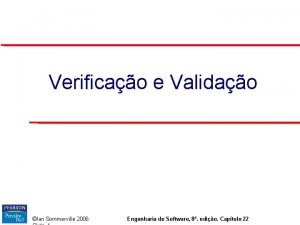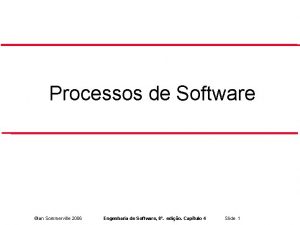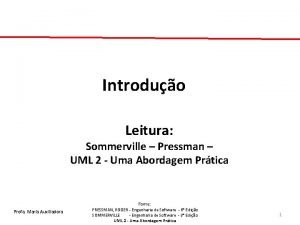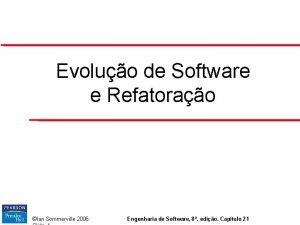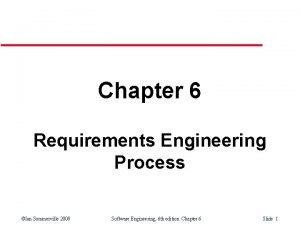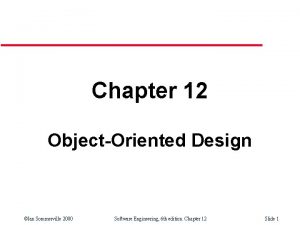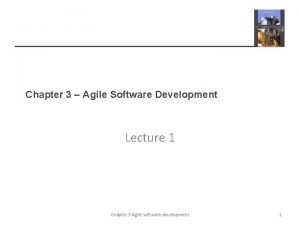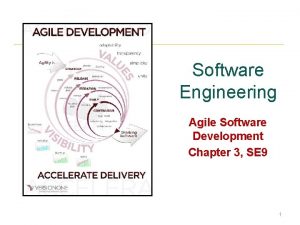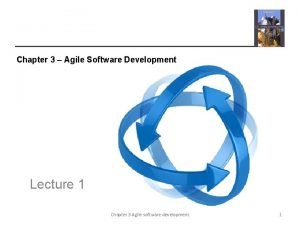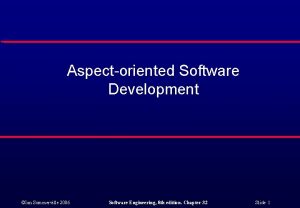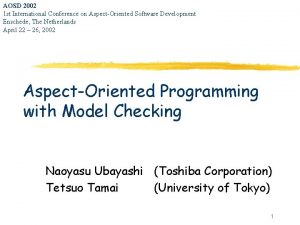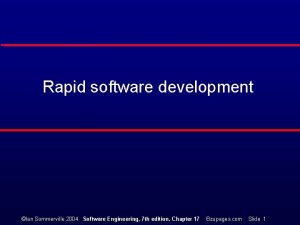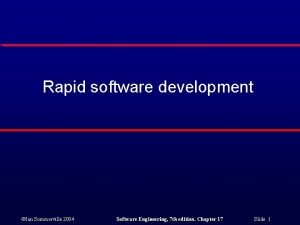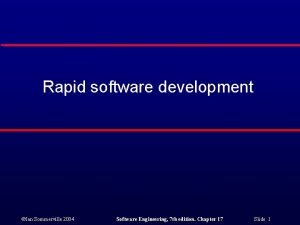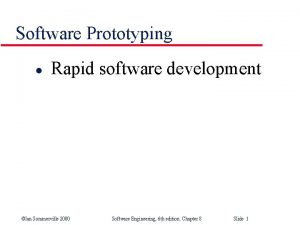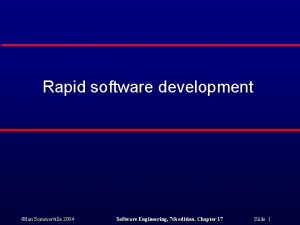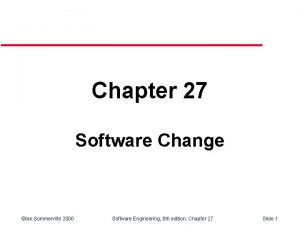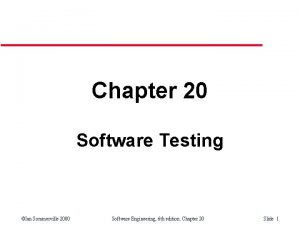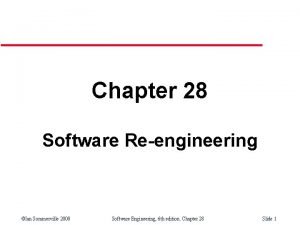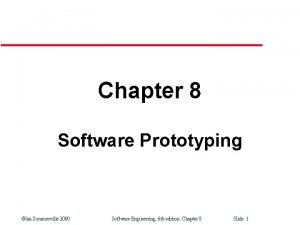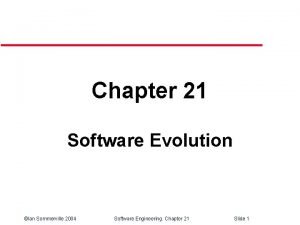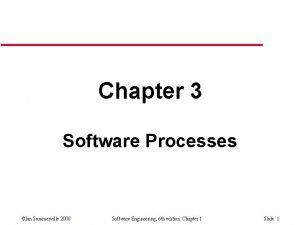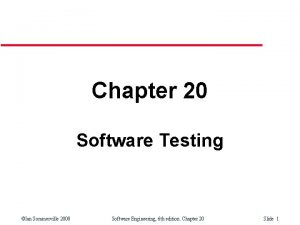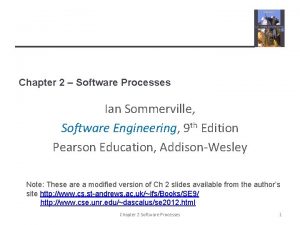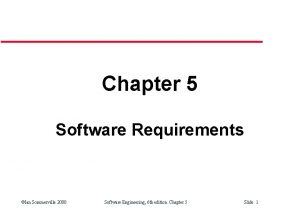Chapter 32 AspectOriented Software Development AOSD Ian Sommerville


















- Slides: 18

Chapter 32 Aspect-Oriented Software Development (AOSD) ©Ian Sommerville 2006 Software Engineering. Chapter 32 Slide 1

Objectives l l To explain the principle of separation of concerns in software development To introduce the fundamental ideas and the associated terminology underlying aspectoriented development ©Ian Sommerville 2006 Software Engineering. Chapter 32 Slide 2

Topics covered l l l Introduction and motivation The separation of concerns Core vs. cross-cutting concerns Aspects, join points and pointcuts Information hiding vs. AOSD Problems with AOSD ©Ian Sommerville 2006 Software Engineering. Chapter 32 Slide 3

Which mapping? ? ©Ian Sommerville 2006 Software Engineering. Chapter 32 Slide 4

Introduction and motivation l l l In most large systems, the mapping between requirements and components is not 1: 1. Thus, implementing a requirements change may involve understanding and changing many components. Aspect-Oriented Software Development (AOSD) is an emerging approach intended to address this problem. (cont’d) ©Ian Sommerville 2006 Software Engineering. Chapter 32 Slide 5

Introduction and motivation (cont’d) l l l Aspects are used to encapsulate concerns (requirements) that cross-cut system components. An aspect-oriented program is created by automatically weaving (i. e. , combining) objects, methods, and aspects. Companies such as IBM are experimenting with aspect-oriented programming languages (e. g. , Aspect. J), but AOSD is not yet mainstream SE. Aspect. J was developed at Xerox PARC and made available in 2001. ©Ian Sommerville 2006 Software Engineering. Chapter 32 Slide 6

What are concerns? l l l Concerns reflect system requirements and the priorities of system stakeholders. Separating concerns in a program via procedures, classes, and aspects clear traceability from requirements This facilitates program understanding and the implementation of requirements change. ©Ian Sommerville 2006 Software Engineering. Chapter 32 Slide 7

Types of concerns l l Functional: related to specific functionality to be included in a system. Quality of service: related to the nonfunctional behaviour of a system (e. g. , performance, reliability, availability). System: related to attributes of the system as a whole (e. g. , maintainability, configurability). Organizational: related to organizational goals and priorities (e. g. , staying within budget, using existing software assets). ©Ian Sommerville 2006 Software Engineering. Chapter 32 Slide 8

Core vs. cross-cutting concerns l l Core concerns relate to a system’s primary purpose and are normally localized within separate procedures, objects, etc. Cross-cutting concerns are normally distributed among a number of program components, resulting in problems when changes are required due to: § § tangling (a component implements multiple requirements), and scattering (a requirement’s implementation is scattered across more than one component). ©Ian Sommerville 2006 Software Engineering. Chapter 32 Slide 9

Cross-cutting concerns Core concerns Account reqmts. Customer management reqmts (tangling) New customer reqmts Security reqmts Cross-cutting concerns Recovery reqmts Internet Banking System ©Ian Sommerville 2006 Software Engineering. Chapter 32 Slide 10

Aspect-oriented software development (AOSD) l l An aspect is an abstraction which encapsulates the code associated with a cross-cutting concern. Aspects include a definition of where they should be included in a program as well as the code implementing the cross-cutting concern. ©Ian Sommerville 2006 Software Engineering. Chapter 32 Slide 11

Aspect terminology l l Advice: the code implementing a concern Pointcut: defines specific program events with which advice should be associated (i. e. , woven into a program at appropriate join points) § l Events may be method calls/returns, accessing data, exceptions, etc. Weaving: incorporation of advice code into the program (via source code preprocessing, link-time weaving, or executiontime weaving) ©Ian Sommerville 2006 Software Engineering. Chapter 32 Slide 12

An “authentication” aspect ©Ian Sommerville 2006 Software Engineering. Chapter 32 Slide 13

Information hiding vs. AOSD Information Hiding: isolating potentially changeable design decisions (core concerns) in separate program components AOSD: isolating potentially changeable “crosscutting concerns” (design decisions that cut across program components) in separate program aspects. ©Ian Sommerville 2006 Software Engineering. Chapter 32 Slide 14

Problems with AOSD l l AO programs can be “black-box tested” using requirements to design the tests, but program inspections and “white-box testing” can be problematic, since you can’t always tell from the source code alone where an aspect will be woven and executed. “Flattening” an aspect-oriented program for reading is problematic. (E. g. , join point model may be dynamic; aspects may be competing. ) ©Ian Sommerville 2006 Software Engineering. Chapter 32 Slide 15

Key points l l l The key benefit of AOSD is that it supports the separation of (requirements related) concerns. Aspects are used to encapsulate concerns that cross-cut system components. An aspect-oriented program is created by automatically weaving (i. e. , combining) objects, methods, and aspects. (cont’d) ©Ian Sommerville 2006 Software Engineering. Chapter 32 Slide 16

Key points (cont’d) l Some consider the problems of inspecting and deriving structural tests for aspectoriented programs to be a significant barrier to the adoption of AOSD. ©Ian Sommerville 2006 Software Engineering. Chapter 32 Slide 17

Chapter 32 Aspect-Oriented Software Development (AOSD) ©Ian Sommerville 2006 Software Engineering. Chapter 32 Slide 18
 Engineering software products ian sommerville
Engineering software products ian sommerville Simple aspect example
Simple aspect example Inżynieria oprogramowania ian sommerville
Inżynieria oprogramowania ian sommerville Sommerville software engineering slides
Sommerville software engineering slides Change management in software testing
Change management in software testing Sommerville
Sommerville Sommerville
Sommerville Sommerville
Sommerville Sommerville
Sommerville Sommerville
Sommerville Sommerville
Sommerville Sommerville
Sommerville Elaine sommerville
Elaine sommerville 666 rule presentation
666 rule presentation Chapter 3 agile software development
Chapter 3 agile software development Chapter 3 agile software development
Chapter 3 agile software development Chapter 3 agile software development
Chapter 3 agile software development Ian milborrow pwc
Ian milborrow pwc Ian juliano
Ian juliano
